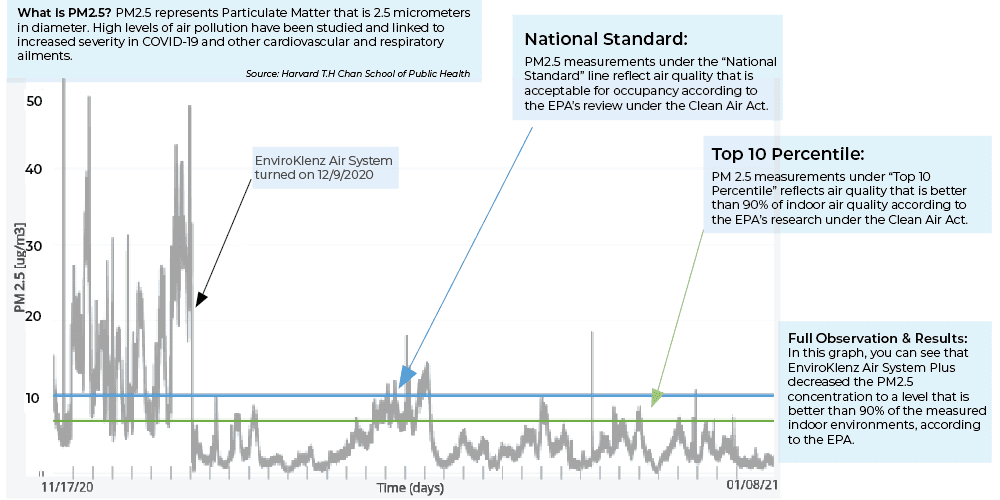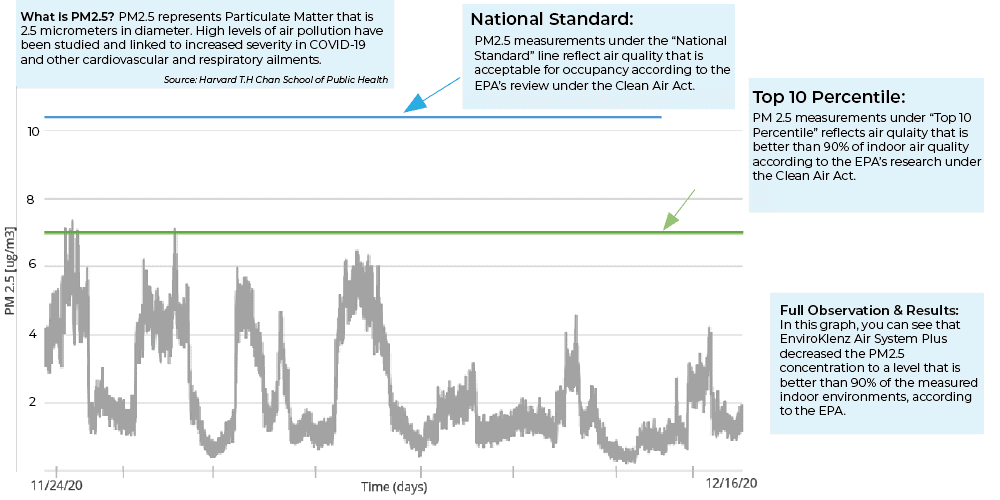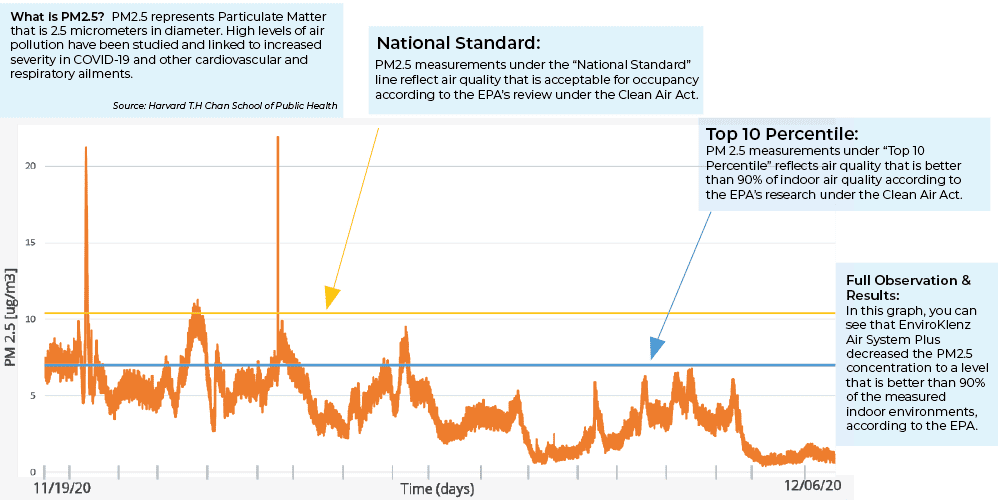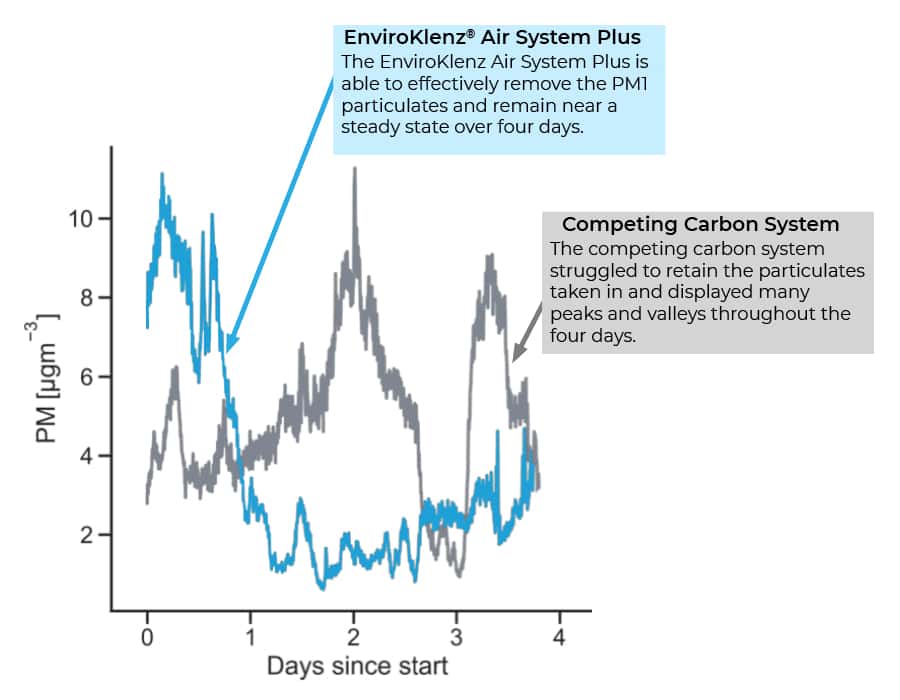The year 2020 brought copious challenges to the field of education. The pandemic put the health and safety of students, teachers, and staff at risk, prompting major changes at every level of education. As a result of the pandemic, schools across the country were faced with the unexpected obstacles of immediate in-person shutdown, followed by the new need for revised procedures and approaches to safe operations; this left many education personnel worried about how this viral hurdle would affect the future of learning. Among other standards, indoor air quality (IAQ) appeared as an obvious concern when handling the risk of an airborne virus and its transmission. This caused educational facilities to invest some thought into how they could best address this issue of keeping classroom air clean in situations of heavy person-to-person interaction, and in some cases, poor ventilation.
According to a U.S. study that analyzed the effects of particulate matter within indoor air, it observed that an 8% increase in death rate results from an increase of 1 ug/m3 of PM2.5 in the air, speaking in terms of virus transmission. This study links together air pollution and COVID-19’s spread, which begins to outline why reducing levels of particulate matter in the air, specifically PM2.5 concentrations, could help improve IAQ and mitigate risks of exposure to easily-transmittable, airborne viruses.
EnviroKlenz® conducted a case study to test the air quality within several classrooms across the country, using the Environmental Protection Agency’s (EPA) national air quality standards as reference; they also analyzed the impact that air purification systems had on the quality of air in these locations.
Find out more about the details and outcomes of this study and how much the IAQ of schools truly matters to the way educational communities will operate moving forward.
Purpose for Analyzing Indoor Air Quality Standards within Schools
With continuous focus on the health and safety of everyone returning to the classrooms amidst COVID-19, IAQ deserves proper attention when seeking the best possible environment for educational operations. People want to know that the schools they are attending are doing everything possible to mitigate risks associated with this contagious airborne virus; proper IAQ is one of many important precautions that schools should be recognizing and addressing in their efforts towards safer classrooms. This is even more relevant for older schools that may experience poor ventilation due to weaker HVAC systems.
As Peter Twadell, the Head of School at Birches School in Lincoln, MA, stated, he “really recognized that… children needed to be in-person with their peers and their teachers in order to really take care of their social and emotional wellbeing, as well as having hands-on and meaningful learning in-person.” Educational leaders realize the challenges COVID-19 has created by compromising in-person experiences, leading to the urgent need for a solution.
EnviroKlenz® worked with QuantAQ, an air quality company that provided their commercial-grade air quality meters, to track particulate matter within classrooms of several East Coast and Midwest schools. The purpose of this study was to gauge the level of particulate matter in the air with and without the use of additional air filtration systems in the room, comparing the two measures and analyzing the benefits that an air filtration system can provide.
“Continuous, real-time air quality monitoring in schools provides the data necessary to verify ventilation, validate filtration mechanisms, and characterize changes in air quality on a classroom-by-classroom basis. QuantAQ’s MODULAIR-PM system captures the size and concentration of particulate matter on a minute-by-minute basis, revealing the precise frequency and duration of elevated air pollution episodes, allowing users to take action in real-time.”
David Hagen
CEO & Co-Founder, QuantAQ
National EPA standards for acceptable indoor particulate matter (PM) were used to evaluate the performance of the EnviroKlenz® Air System Plus. Particulate matter was continuously measured by air meters in rooms using the Air System Plus. While various sizes of PM were measured, this study focused on the smallest particles, PM1. These particles are 1 micrometer in size, about 70 times smaller than the diameter of human hair.
How Air Purification Systems Improve Classroom IAQ
Results of the case study reveal dramatic improvements in PM 2.5 and PM1 levels upon using the EnviroKlenz® Air System Plus, consistently exceeding the EPA national standards of 10ug/m3 of PM2.5 and remaining within their top 10 percentile of proficient IAQ. Take a look at the graphical results below for a better idea of how effectively the Air System Plus performs in all testing.

Graph 1: Results of PM2.5 Concentrations in East Coast School using the EnviroKlenz® Air System Plus
In one East Coast school, the Air System Plus dramatically reduces the PM2.5 concentrations to well below EPA’s national standard of 10ug/m3 upon being turned on. These results are consistent throughout the system’s performance, even through expected spikes of PM2.5 levels during the busier holiday season.

Graph 2: Results of PM2.5 Concentrations in Dental College using the EnviroKlenz® Air System Plus
Looking at a dental college’s results, the Air System Plus consistently keeps PM2.5 levels below 6ug/m3, falling within the top 10 percentile of EPA’s standards. This is impressive considering the aerosol and non-aerosol activities performed by its dental students, which contributes to typical particulate matter found in the air.

Graph 3: Results of PM2.5 Concentrations in Midwest Public School using the EnviroKlenz® Air System Plus
A Midwest public school had successful results with the Air System Plus in their facilities, showing consistent levels of PM2.5 that exceed EPA’s national standards of 10ug/m3 and below. It steadily falls within the top 10 percentile during the latter half of its testing period. These results show how efficient EnviroKlenz’s® technology is, as these three sets of testing all support the Air System Plus’s ability to bring IAQ to superior, safe levels, especially when using EPA’s national standards as a basis for acceptable concentrations of particulate matter.

Graph 4: EnviroKlenz® Air System Plus vs. Competing Carbon System
Additionally within the study, EnviroKlenz® outperforms a competing carbon air purifier. The Midwest Public School used the two systems in the same facility at different times. The EnviroKlenz® system quickly and consistently removes particulate matter from the air, outperforming the competitor’s system.
Why Educational Operations Choose EnviroKlenz®
There are many air purification systems currently in the marketplace, with wide variations in quality, features, and performance. The results of EnviroKlenz’s® study, which prove the effectiveness of the Air System Plus, are compelling. In addition to this testing, many EnviroKlenz® customers in the field of education recommend the Air System Plus, having found that the price, portability, safety, and performance of the system make it the right choice for their classrooms.
The ultimate goal of educational facilities is to have the safest environment for its members to return to and learn in. Peter Twadell noticed the performance quality of the Air System Plus, remarking how “they work as advertised, they’ve been incredibly reliable, (and choosing EnviroKlenz®) was an easy ‘yes’ once we understood how much air they were going to turn over.” The Air System Plus has a powerful air exchange rate of 18 exchanged per hour in a 1,000 cubic foot area. This quick turnover is especially relevant for cleaning a classroom’s IAQ in timeframes of high traffic, such as entering the room at the beginning of the day and after breaks, as well as following periods of inactivity when the school day is over.
Safety features are an important consideration, especially when using an air purification system in classrooms with young children. This was one of Dawn Smith’s concerns, the Director of Operations at Luzerne County Head Start.
“We deal with 3–5-year-olds, (and it) was such a huge component for us knowing that there was no way that the UV light was going to come out of that machine and be exposing anybody. Also, knowing that the units have been tested and particles smaller than COVID had been trapped and killed in the units…was really the guiding light for me. No other units that I looked into could say that they did the same thing. No other units had the UV lights, the HEPA filter, and the air filter, so all of those components, and the safety features, were huge.” Dawn Smith
Director of Operations, Luzerne County Head Start
Long-term Benefits of Air Purification Systems in Schools
Air quality is an evergreen factor that will continue to impact the education world. Given the culture of students and teachers coming in and out of the classrooms each day, bringing with them germs, allergies, and even odors, the need for air purification spans much larger than just the present concerns of COVID-19.
“When we’re operating more normally, maybe we’ll be able to cut down on some of the traditional flu-peaks that schools have, or cold peaks, that kids just bring into school, by managing the airborne virus and bacteria quality.”Peter Twadell
Head of School, Birches School
EnviroKlenz® Air System Plus provides many benefits through its proven technology that appeal to educational operators and their concern for proper IAQ. These include:
- Patented earth-mineral technology within its air cartridge, paired with UV-C lights and HEPA filtration;
- Ability to capture and destroy 99.9% of airborne toxic and noxious gases, particulates, viruses, bacteria, and other harmful pathogens;
- Non-toxic earth mineral technology that is trusted by the US military for destroying chemical warfare, yet completely safe and user-friendly for all types of environments;
- Removal of allergens and dust from the air for allergy and asthma-prone people;
- Elimination of odors;
- Affordability of units.
Overcoming the challenges of this past year has shown its educational leaders what it takes to promote safe and efficient learning. This unique time taught teachers, students, and parents just how vital it is to have that personal interaction in the classroom, an experience that can’t be fully achieved by virtual means. This really stuck with Peter Twadell, who hopes that “we come out of all this with a more humanistic and a more balanced approach to make sure every kid gets what they need to thrive,” as he is a big believer in the importance of children gaining educational experiences in-person. Addressing IAQ and establishing ways to maintain its best quality brings schools across the nation closer to this chance at more normalcy. With the solution of air purification systems, like that of EnviroKlenz®, the future health and safety of schools has a bright road ahead.
EnviroKlenz® Medical Disclaimer:
“Any information that is provided on this website is not for the use by any commercial or personal entity without expressed written consent of the blog author. The material and statements illustrated within this blog are not intended to diagnose, treat, cure, or prevent any diseases or medical conditions. Nor does the author in any way guarantee or validate the validity, totality, or efficacy of any claims and will therefore not be held responsible for the content of any claims. Always consult your medical physician for any specific medical advice or recommendations.”








